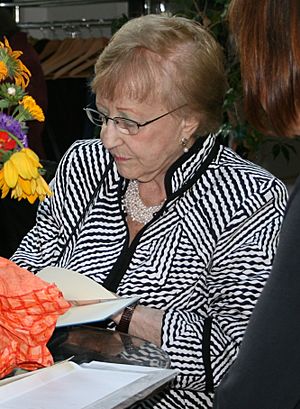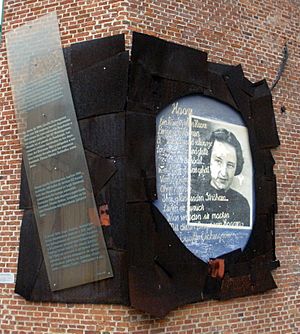Lucille Eichengreen facts for kids
Quick facts for kids
Lucille Eichengreen
|
|
|---|---|

Lucille Eichengreen in 2012, signing one of her books
|
|
| Born |
Cecilie Landau
February 1, 1925 Hamburg, Germany
|
| Died | February 7, 2020 (aged 95) Oakland, California, U.S.
|
| Occupation |
|
| Organization |
|
| Known for | Holocaust survivor |
| Awards |
|
Lucille Eichengreen (born Cecilie Landau; February 1, 1925 – February 7, 2020) was a brave woman who survived the Łódź Ghetto and several Nazi German concentration camps. These included Auschwitz, Neuengamme, and Bergen-Belsen.
After the terrible events of the Holocaust, she moved to the United States in 1946. There, she got married and had two sons. Lucille also worked as an insurance agent. In 1994, she wrote a book called From Ashes to Life: My Memories of the Holocaust. She often gave talks about the Holocaust at schools, libraries, and universities. She wanted to make sure people never forgot what happened. She even helped create a documentary about life in the Ghetto for the University of Giessen. For her work, she received an honorary doctorate.
Contents
Lucille Eichengreen's Life Story
Early Life in Germany
Lucille Eichengreen was born Cecilie Landau in Hamburg, Germany, on February 1, 1925. She was the older of two daughters. Her father, Benjamin Landau, was a wine merchant from Poland. Her mother was Sala Baumwollspinner.
Lucille remembered her childhood as "very nice, very comfortable." This was before Adolf Hitler came to power in 1933. After that, life became very hard for Jewish people. The Nazis made many harsh rules against them. Jewish people also faced insults and attacks from others.
In 1939, her father, Benjamin Landau, was arrested by the Gestapo. This happened when Germany attacked Poland. He was taken to different concentration camps. Sadly, he was murdered on December 31, 1940, at Dachau concentration camp.
Life in the Ghetto and Camps
On October 25, 1941, when she was 16, Lucille was sent away. She was deported to the Łódź Ghetto with her mother and younger sister, Karin. A ghetto was a special area where Jewish people were forced to live. Conditions there were very bad. Many people starved. Lucille's mother died of starvation on July 13, 1942.
Lucille tried to take care of her younger sister, Karin. But in September 1942, Karin was separated from her. Karin was only eleven years old. She was sent to Chełmno extermination camp and murdered.
Lucille found work as a secretary for a writer named Oskar Singer. In 1943, she was hurt during an interrogation by the Nazi police. She was hit on her left ear. This caused her to become permanently deaf in that ear.
Surviving the Camps
In August 1944, Lucille was deported to Auschwitz concentration camp. This was a very dangerous place. She was chosen to work during the selection process. This meant she was considered strong enough to work.
A few weeks later, she went through another selection. The camp doctor, Josef Mengele, sent her to a different camp. This was a satellite camp of Neuengamme concentration camp. There, she had to do very hard work. She helped with construction and cleared away rubble from bomb damage. Later, she was given office work. But she still faced harsh treatment from her supervisors. In March 1945, she was sent to Bergen-Belsen concentration camp.
After the War: A New Beginning
Lucille was the only one in her close family to survive the Holocaust. She didn't know for sure that her sister had died until 1947. After the British army freed the Bergen-Belsen camp, Lucille stayed there for a few months. She worked as a translator for the British.
She helped the British forces find 40 members of the SS. These were people who had worked at the Neuengamme concentration camp. Her help led to their arrest and trial. After receiving threats to her life, she moved to the United States. There, she married Dan Eichengreen, another Jewish person who had moved from Hamburg.
Lucille said it was hard to get over the terrible things she had experienced. She often had nightmares. In 1995, she went back to Poland and Germany for the first time since 1945. She visited Hamburg, Auschwitz, and the former Łódź ghetto. She wanted to face her past and share her story.
Lucille Eichengreen lived in Oakland, California. One of her two sons is a well-known American economist, Barry Eichengreen. Lucille passed away on February 7, 2020, shortly after her 95th birthday.
Sharing Her Story: Lucille's Work
Writing and Lecturing
In the 1990s, Lucille Eichengreen started writing about her experiences. Her book, From Ashes to Life: My Memories of the Holocaust, was published in the United States in 1994. After visiting Germany, she began giving talks. She spoke at schools, universities, and special events. She wanted to teach people about the Holocaust.
She also worked with the University of Giessen. She helped them with the chronicles of the Łódź ghetto. This was a text that described what life was like in the ghetto. For her important work, she received an honorary doctorate from the university in May 2007. This was a special award for her contributions to language, culture, and literature.
Awards and Recognition
In 2009, there was an exhibition in Hamburg called Sent to Death: The Deportation of Jews, Roma and Sinti from Hamburg, 1940 to 1945. During this event, Lucille was given the Hamburger Ehrendenkmünze in Gold. This is a special gold medal of honor from Hamburg. The mayor, Ole von Beust, gave her this award. In 2015, a special book was published to honor her work.
See also
 In Spanish: Lucille Eichengreen para niños
In Spanish: Lucille Eichengreen para niños


